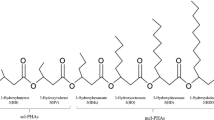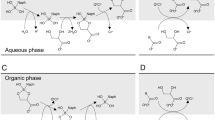Abstract
A simple and effective method for the recovery poly(3-hydroxybutyrate) [P(3HB)] directly from high cell density culture broth with no pretreatment steps has been developed. This method consists of direct addition of sodium dodecyl sulfate (SDS) to the culture broth, shaking, heat treatment, and washing steps. When the SDS/biomass ratio was higher than 0.4, the purity of recovered P(3HB) was over 95% for various cell concentrations of 50–300 g dry cell l−1, with the highest value of 97%. The recovery of P(3HB) was over 90% regardless of cell concentration and SDS dosage (SDS/biomass ratios, 0.1–0.7). One g SDS digests 0.72 g non-P(3HB) cell materials. The reduction in molecular weight, due to degradation of P(3HB) by SDS, was negligible.
Similar content being viewed by others
References
Berger E, Ramsay BA, Ramsay JA, Chavarie C, Braunegg G (1989) P(3HB) recovery by hypochlorite digestion of non-P(3HB) biomass. Biotechnol. Tech. 3: 227–232.
Brandle H, Gross RA, Lenz RW, Fuller RC (1990) Plastics from bacteria and for bacteria: poly(?-hydroxyalkanoates) as natural, biocompatible, and biodegradable polyesters. Adv. Biochem. Eng. Biotechnol. 41: 77–93.
Cho KS, Ryu HW, Lee EG, Chang YK (2000) Separation of Alcaligenes eutrophus cells containing poly(3-hydroxybutyrate) from fermentation broth with pretreatment using Al-and Fe-based coagulants. Biotechnol. Prog. 16: 238–243.
Choi JI, Lee SY (1999) Efficient and ecomonical recovery of poly(3-hydroxybutyrate) from recombinant Escherichia coli by simple digestion with chemicals. Biotechnol. Bioeng. 62: 546–553.
de Koning G, Witholt B (1997) A biodegradable rubber from bacteria, poly(hydroxyalkanote) from Pseudomonads. Mat. Sci. Eng. C4: 121–124.
Hahn SK, Chang YK, Kim BS, Chang HN (1994) Optimization of microbial poly(3-hydroxybutyrate) recovery using dispersions of sodium hypochlorite solution and chloroform. Biotechnol. Bioeng. 44: 256–261.
Huang R, Reusch RN (1996) Poly(3-hydroxybutyrate) is associated with specific proteins in the cytoplasm and membranes of Esherichia coli. J. Biol. Chem. 271: 22196–22202.
Lafferty RM, Korsatko B, Korsatko W (1988) Microbial production of poly-?-hydroxybutyric acid. In: Rehm HJ, Reed G, eds. Biotechnology, Vol. 6b. Weinheim: VCH, pp. 135–176.
Ramsay JA, Berger E, Ramsay BA, Chavarie C (1990) Recovery of poly-?-hydroxybutyric acid granules by a surfactanthypochlorite treatment. Biotechnol. Tech. 8: 589–594.
Ramsay JA, Berger E, Voyer R, Chavarie C, Ramsay BA (1994) Extraction of poly-?-hydroxybutyrate using chlorinated solvents. Biotechnol. Tech. 8: 589–594.
Ryu HW, Hahn SK, Chang YK, Chang HN (1997) Production of poly(3-hydroxybutyrate) by high cell density fed-batch culture of Alcaligenes eutrophus with phosphate limitation. Biotechnol. Bioeng. 55: 28–32.
Steinbuchel A, Fuchtenbusch B (1998) Bacterial and other biological systems for polyester production. Trends Biotechnol. 16: 419–427.
Author information
Authors and Affiliations
Corresponding author
Rights and permissions
About this article
Cite this article
Kim, M., Cho, KS., Ryu, H.W. et al. Recovery of poly(3-hydroxybutyrate) from high cell density culture of Ralstonia eutropha by direct addition of sodium dodecyl sulfate. Biotechnology Letters 25, 55–59 (2003). https://doi.org/10.1023/A:1021734216612
Issue Date:
DOI: https://doi.org/10.1023/A:1021734216612




